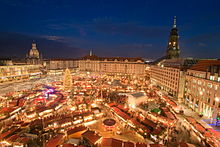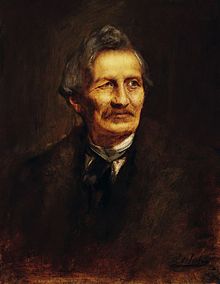Outline of Dresden
Appearance
The following outline is provided as an overview of and topical guide to Dresden:
Dresden – capital and the most populated city in the German state of Saxony. With over 547,172 residents in 328.8 km2 (127.0 sq mi) it is also Germany's twelfth largest Großstadt. Dresden is one of the most visited cities in Germany.
General reference
- Pronunciation: German pronunciation: [ˈdʁeːsdn̩] ;[1]
- Common English name(s): Dresden
- Official English name(s): City of Dresden
- Adjectival(s): Dresdener
- Demonym(s): Dresdener
Geography of Dresden
- Dresden is:
- Population of Dresden: 547,172
- Area of Dresden: 328.8 km2 (127.0 sq mi)
- Atlas of Dresden
Dresden | |
|---|---|
Location within Germany | |
| Coordinates: 51°2′N 13°44′E / 51.033°N 13.733°E |
Location of Dresden
Dresden is situated within the following regions:
- Northern Hemisphere and Eastern Hemisphere
- Time zone(s):
- Central European Time (UTC+01)
- In Summer (DST): Central European Summer Time (UTC+02)
Environment of Dresden
Landforms of Dresden


Geography and urban development of Dresden
- Highlands in Dresden
- Rivers in Dresden
- Valleys in Dresden
Areas of Dresden
Districts of Dresden
Neighborhoods in Dresden


- Albertstadt
- Äußere Neustadt
- Blasewitz
- Buehlau
- Friedrichstadt
- Hellerau
- Innere Neustadt
- Loschwitz
- Mickten
- Neumarkt
- Pillnitz
Locations in Dresden
- Tourist attractions in Dresden
- Shopping areas and markets
- World Heritage sites in Dresden
Bridges in Dresden

Castles in Dresden

Cultural and exhibition centres in Dresden
Monuments and memorials in Dresden
Museums and art galleries in Dresden


- Albertinum
- Bundeswehr Military History Museum
- Dresden City Art Gallery
- Dresden City Museum
- Dresden Museum of Ethnology
- Dresden Transport Museum
- Galerie Neue Meister
- Gemäldegalerie Alte Meister
- German Hygiene Museum
- Grünes Gewölbe
- Semper Gallery
- State Museum of Zoology
Palaces and villas in Dresden

- Albrechtsberg Palace
- Japanisches Palais
- Kaiserpalast
- Palais Flemming-Sulkowski
- Pillnitz Castle
- Wackerbarth-Palais
- Zwinger
Parks and gardens in Dresden

Public squares in Dresden
Religious buildings in Dresden

- Church of Reconciliation
- Dresden Cathedral
- Dresden Frauenkirche
- Himmelfahrtskirche
- Kreuzkirche
- New Synagogue
- Semper Synagogue
- St. Simeon of the Wonderful Mountain Church
- Trinitatiskirche
- Zionskirche
Secular buildings in Dresden



- Johanneum
- Landhaus
- Dresden Panometer
- Orpheum Dresden
- Sächsische Staatskanzlei
- Sächsisches Ständehaus
- Saxon Landtag
- Saxon State and University Library Dresden
- Taschenbergpalais
- Yenidze
Streets in Dresden
Theatres in Dresden
- Festspielhaus Hellerau
- Opernhaus am Taschenberg
- Opernhaus am Zwinger
- Semperoper
- Societaetstheater
- Staatsschauspiel Dresden
Towers in Dresden
Demographics of Dresden
Government and politics of Dresden

Government and politics of Dresden
- City Council of Dresden
- International relations of Dresden
- Sister cities of Dresden
 Saint Petersburg, Russia, since 1961
Saint Petersburg, Russia, since 1961 Florence, Tuscany, Italy, since 1978
Florence, Tuscany, Italy, since 1978 Hamburg, Germany, since 1987
Hamburg, Germany, since 1987 Salzburg, Austria, since 1991
Salzburg, Austria, since 1991
- Sister cities of Dresden
History of Dresden
History of Dresden, by period or event

- Early history
- Kingdom of Saxony – Dresden becomes the capital of the Kingdom of Saxony (1806–1918)
- Battle of Dresden (1813)
- May Uprising in Dresden (1849)
- Free State of Saxony – Dresden becomes the capital of the first Free State of Saxony (1918–1934)
- Dresden during the Second World War
- Dresden post-reunification
History of Dresden, by subject
Culture of Dresden



- Events in Dresden
- Annual events in Dresden
- Festivals in Dresden
- Languages in Dresden
- Media in Dresden
- Newspapers in Dresden
- Radio and television in Dresden
- Recreation in Dresden
Arts in Dresden


Architecture of Dresden
Cinema of Dresden
Music of Dresden
- Music schools in Dresden
- Music venues in Dresden
- Musical compositions written or adapted for Dresden:
- Around 1728 Jan Dismas Zelenka expanded the Missa Providentiae, originally a Kyrie–Gloria Mass by Antonio Caldara, with a Credo (ZWV 31), Sanctus and Agnus Dei into a Missa tota for use at the then-time Prince-Electoral and Royal-Polish Catholic court in Dresden.[2][3]
- Kyrie–Gloria Mass in B minor, BWV 232 I (1733), by Johann Sebastian Bach.[3]
- Missa Sanctissimae Trinitatis, ZWV 17 (1736), and Missa Votiva, ZWV 18 (1739), by Jan Dismas Zelenka.
- Musical ensembles in Dresden
Visual arts of Dresden
Dresden in art / Paintings of Dresden
Cuisine of Dresden

People of Dresden
Religion in Dresden
- Catholicism in Dresden
Sports in Dresden


- Basketball in Dresden
- Football in Dresden
- Ice hockey in Dresden
- Sport venues in Dresden
Economy and infrastructure of Dresden

- Banking in Dresden
- Industry in Dresden
- Tourism in Dresden
- Tourist attractions in Dresden
Transportation in Dresden



- Public transport operators
- Air transport in Dresden
- Maritime transport in Dresden
Rail transport in Dresden
- Dresden Funicular Railway
- Dresden Park Railway
 Dresden S-Bahn
Dresden S-Bahn
- S-Bahn stations in the Dresden inner city
- Dresden Suspension Railway
- Trams in Dresden
Road transport in Dresden
Education in Dresden

Public education in Dresden
- Secondary education in Dresden
- Institutions of higher education in Dresden
- Universities in Dresden
- Research institutes in Dresden
Publications about Dresden
See also
References
- ^ Names of European cities in different languages: C–D#D
- ^ RISM 212006716
- ^ a b Stockigt, Janice B. (2013). "Bach's Missa BWV 232I in the context of Catholic Mass settings in Dresden, 1729–1733". In Tomita, Yo; Leaver, Robin A.; Smaczny, Jan (eds.). Exploring Bach's B-minor Mass. Cambridge University Press. pp. 39–53. ISBN 978-1-107-00790-1.



